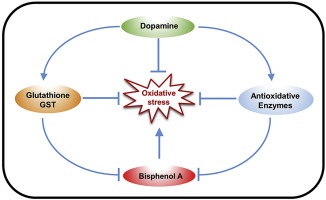Environmental Pollution ( IF 8.9 ) Pub Date : 2020-01-09 , DOI: 10.1016/j.envpol.2020.113957 Golam Jalal Ahammed 1 , Yaqi Wang 1 , Qi Mao 1 , Meijuan Wu 1 , Yaru Yan 1 , Jingjing Ren 1 , Xiaojuan Wang 1 , Airong Liu 1 , Shuangchen Chen 1

|
Bisphenol A (BPA) is an emerging organic pollutant, widely distributed in environment. Plants can uptake and metabolize BPA, but BPA accumulation induces phytotoxicity. In this study, we administered dopamine, a kind of catecholamines with strong antioxidative potential, to unveil its role in cucumber tolerance to BPA stress. The results showed that exposure to BPA (20 mg L−1) for 21 days significantly reduced growth and biomass accumulation in cucumber seedlings as revealed by decreased lengths and dry weights of shoots and roots. While BPA exposure decreased the chlorophyll content, cell viability and root activity, it remarkably increased reactive oxygen species (ROS) accumulation, electrolyte leakage and malondialdehyde (MDA) content, suggesting that BPA induced oxidative stress in cucumber. However, exogenous dopamine application significantly improved the photosynthetic pigment content, root cell viability, growth and biomass accumulation, and decreased the ROS and MDA levels by increasing the activity of antioxidant enzymes under BPA stress. Further analysis revealed that dopamine application significantly increased the glutathione content and the transcripts and activity of glutathione S-transferase under co-administration of dopamine and BPA compared with only BPA treatment. Moreover, dopamine decreased the BPA content in both leaves and roots, suggesting that dopamine promoted BPA metabolism by enhancing the glutathione-dependent detoxification. Our results show that dopamine has a positive role against BPA phytotoxicity and it may reduce the risks-associated with the dietary intake of BPA through consumption of vegetables.
中文翻译:

多巴胺可通过增强黄瓜中的抗氧化剂和解毒潜力来缓解双酚A诱导的植物毒性。
双酚A(BPA)是一种新兴的有机污染物,广泛分布于环境中。植物可以吸收和代谢BPA,但BPA积累会诱导植物毒性。在这项研究中,我们施用了多巴胺(一种具有强抗氧化潜力的儿茶酚胺),以揭示其在黄瓜对BPA胁迫的耐受性中的作用。结果表明,接触BPA(20 mg L -1)21天显着减少了黄瓜幼苗的生长和生物量积累,这通过降低茎和根的长度和干重可以看出。虽然BPA暴露降低了叶绿素含量,细胞活力和根系活性,但显着增加了活性氧(ROS)积累,电解质泄漏和丙二醛(MDA)含量,表明BPA诱导了黄瓜的氧化胁迫。然而,外源多巴胺的应用显着提高了光合色素含量,根细胞活力,生长和生物量积累,并通过增加BPA胁迫下抗氧化酶的活性而降低了ROS和MDA含量。进一步的分析表明,多巴胺的施用显着增加了谷胱甘肽的含量以及谷胱甘肽的转录本和活性与仅BPA治疗相比,多巴胺和BPA并用时的S-转移酶。此外,多巴胺降低了叶和根中的BPA含量,表明多巴胺通过增强谷胱甘肽依赖性排毒来促进BPA代谢。我们的结果表明,多巴胺对BPA的植物毒性具有积极作用,并且可以通过食用蔬菜来降低与BPA饮食摄入相关的风险。



























 京公网安备 11010802027423号
京公网安备 11010802027423号